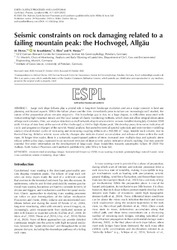Seismic constraints on rock damaging related to a failing mountain peak: the Hochvogel, Allgäu
Dietze, M.; Krautblatter, M.; Illien, L.; Hovius, N., 2020: Seismic constraints on rock damaging related to a failing mountain peak: the Hochvogel, Allgäu. In: Earth Surface Processes and Landforms, Band 46, 2: 417 - 429, DOI: 10.23689/fidgeo-4048.
 |
Dokument öffnen: |
Large rock slope failures play a pivotal role in long‐term landscape evolution and are a major concern in land use planning and hazard aspects. While the failure phase and the time immediately prior to failure are increasingly well studied, the nature of the preparation phase remains enigmatic. This knowledge gap is due, to a large degree, to difficulties associated with instrumenting high mountain terrain and the local nature of classic monitoring methods, which does not allow integral observation of large rock volumes. Here, we analyse data from a small network of up to seven seismic sensors installed during July–October 2018 (with 43 days of data loss) at the summit of the Hochvogel, a 2592 m high Alpine peak. We develop proxy time series indicative of cyclic and progressive changes of the summit. Modal analysis, horizontal‐to‐vertical spectral ratio data and end‐member modelling analysis reveal diurnal cycles of increasing and decreasing coupling stiffness of a 260,000 m3 large, instable rock volume, due to thermal forcing. Relative seismic wave velocity changes also indicate diurnal accumulation and release of stress within the rock mass. At longer time scales, there is a systematic superimposed pattern of stress increased over multiple days and episodic stress release within a few days, expressed in an increased emission of short seismic pulses indicative of rock cracking. Our data provide essential first order information on the development of large‐scale slope instabilities towards catastrophic failure. © 2020 The Authors. Earth Surface Processes and Landforms published by John Wiley & Sons Ltd. We use a small seismic networks on the summit of the Hochvogel to record continuous and discrete failure preparation signals of a large‐scale slope instability. Reversible and irreversible mechanisms at the diurnal, multi‐day and seasonal scale are quantified.
We infer an early stage of stick slip motion and thermally forced diurnal stress release and rock mass stiffness changes.
Statistik:
ZugriffsstatistikSammlung:
Schlagworte:
environmental seismologyfatigue
fundamental frequency
HVSR
mass wasting
mountain geomorphology
natural hazard
noise cross correlation
seismic monitoring
slope failure
This is an open access article under the terms of the Creative Commons Attribution License, which permits use, distribution and reproduction in any medium, provided the original work is properly cited.

